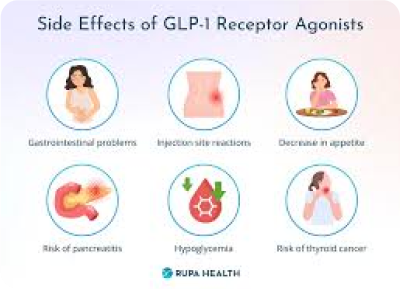How To Manage Gastrointestinal Side Effects of GLP-1 Agonists
GLP-1 agonists are generally well tolerated by patients as a medical weight loss option; however, the main side effects are gastrointestinal, which include nausea, vomiting, diarrhea, and constipation. Here are some ways to manage these side effects:
Nausea
- Avoid strong smells and eat crackers, mint, or ginger-based food or drinks about 30 minutes after taking the medication.
- Vitamin B6
- Prescription anti-nausea medications like Zofran
- Anti-reflux medications like omeprazole or pantoprazole (over-the-counter or prescription).

Vomiting
- Stay hydrated and eat smaller meals more frequently.
- If vomiting persists, contact your doctor to discuss anti-vomiting medications like Zofran.
Diarrhea
- Drink plenty of water and avoid dairy products and high-fiber foods until symptoms go away.
- You can add water-soluble fiber like Metamucil to regulate your bowels.
Constipation
- Get enough fiber in your diet and drink plenty of water.
- Consider an over-the-counter laxative.
- You can add water-soluble fiber like Metamucil to regulate your bowels. Make sure you drink plenty of water.
Other Ways to Manage Side Effects of GLP-1 Drugs
- Starting treatment at a low dose and gradually increasing it
- Taking the medication with food
- Eating smaller, more frequent, high-fiber meals
- Rotating injection sites and using proper injection techniques
- Using cold compresses to reduce pain
- Regularly monitoring symptoms and following the prescribed regimen
- Cold compresses on the wrists help stimulate the nausea/vomiting center in the brain
Mild-to-moderate gastrointestinal symptoms are not usually a sign that your treatment is not working. Most people who experience side effects say that they go away within a few weeks.
This is for informational purposes only. For medical advice or diagnosis, consult a medical professional.
Managing Side Effects of GLP-1 Agonists
Preventing Nausea
- Stay hydrated. Drink plenty of water and/or sugar-free beverages throughout the day, as dehydration can worsen your nausea.
- Eat slowly and stop when satisfied. Chew your food thoroughly to ease the digestive workload on your stomach.
- Eat smaller meals more frequently to stabilize blood sugar levels and alleviate nausea.
- Avoid high-fat foods, as they take longer to digest and can cause discomfort and nausea.
- Avoid spicy foods, which can irritate the stomach lining.
- Limit or avoid alcohol, as it can irritate the stomach lining and affect fluid and electrolyte balance.
- Avoid eating too close to bedtime (wait at least 2-3 hours after a meal).
- Avoid vigorous activity after meals; opt for light activities like walking.
- Practice relaxation techniques such as guided imagery to control nausea.
Tips for Managing Nausea
- Don’t eat and drink simultaneously; separate fluids 30-60 minutes before and after meals.
- Choose mild-smelling foods and opt for chilled or room-temperature options.
- Drink ginger or peppermint tea to alleviate symptoms.
- Don’t skip meals; consume light options like protein shakes, meal replacements, bone broth, or soup with protein and soft vegetables.
Tips for Managing Constipation
- Drink plenty of water or sugar-free beverages.
- Increase fiber intake by consuming:
- Whole grain products like barley, oats, brown or wild rice, and quinoa.
- Foods with 100% whole wheat, rye, oats, or bran as the first ingredient.
- Fresh fruits and vegetables with skins on.
- Beans.
- Exercise to stimulate gastric motility.
- Consider fiber supplements, but consult your doctor or dietitian first.
- If symptoms persist, talk to your clinician about advanced treatments.
Tips for Managing Diarrhea
- Sip fluids like water, broth, and low-sugar electrolyte beverages throughout the day.
- Eat small, frequent meals.
- Avoid lactose, caffeine, alcohol, sugary drinks, and sugar alcohols (e.g., sorbitol, mannitol, xylitol).
- Eat foods that are low in fat and fiber, such as:
- Soft fruits like applesauce or a ripe banana
- Turkey and cheese sandwich
- Broth-based soups like chicken and rice soup
- Well-cooked vegetables without seeds or skin, such as carrots or green beans
- Avoid spicy foods if they worsen your symptoms.
This is for informational purposes only. For medical advice or diagnosis, consult a medical professional.
